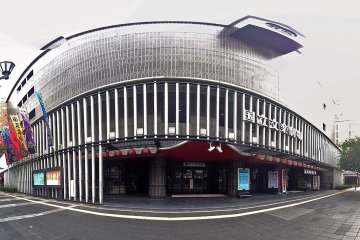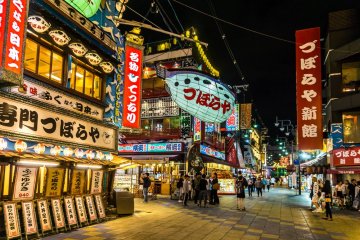
Le Château d'Osaka
Le château d'Osaka (ou Osaka-jô) est l'un des symboles de la ville d'Osaka. L'ensemble de la zone s'étend sur environ deux ki...

Le parc du château d'Osaka est un parc urbain public et un site historique de la préfecture du même nom. Il est situé au sud de la rivière Ōkawa et occupe une grande superficie dans le centre-ville d'Osaka. Ce parc est le deuxième plus grand parc de la ville et été construit sur un site chargé d'histoire.
Le parc du château occupe une surface totale d'environ deux kilomètres carrés. Outre les vastes espaces verts et les installations sportives, il comprend également une arène polyvalente (Osakajo Hall) et un sanctuaire dédié à Toyotomi Hideyoshi, un commandant et homme politique japonais qui a contribué de façon décisive à l'unification du Japon moderne. Toyotomi Hideyoshi a construit le château d'Osaka en 1583 afin de régner sur le Japon depuis Osaka.
Début avril, le parc du château d'Osaka est l'un des endroits les plus populaires pour voir les fleurs de cerisier.

Le château d'Osaka (ou Osaka-jô) est l'un des symboles de la ville d'Osaka. L'ensemble de la zone s'étend sur environ deux ki...

De prime abord, l'hôtel Sheraton Miyako à Osaka ne paie pas de mine, mais le service qui y est proposé est de très haute qualité. Très bien situé, à deux pas de Namba et de Tsuruhashi, des navettes au départ de l'hôtel vous permettent de rejoindre facilement l'aéroport d'Itami ou l'aéroport du Kansai.

L'étonnant Owl Café d'Osaka : une expérience déroutante d'un animal café peu ordinaire

A la découverte de quelques bars insolites et d'un restaurant vraiment original à Osaka !

Parmi les spécialités culinaires du Kansai, la région où se trouve Osaka, on retrouve l'okonomiyaki, une délicieuse crêpe épaisse salée. A l'occasion, goûtez donc à un okonomiyaki préparé par un des cuisiniers des restaurants Fukutarō, et vous m'en direz des nouvelles!

Osaka est depuis des siècles la capitale du Bunraku, théâtre de marionnettes japonais traditionnel. Le Théâtre National composé de deux salles et d'une salle d'exposition, situé dans le quartier Chuo-ku. Le théâtre est maintenant l'un des rares endroits où cette forme d'art fascinante du bunraku peut être vue. Le complexe a ouvert en 1984 en tant que quatrième théâtre national du pays et est devenu le siège du Bunraku. Le Théâtre national est géré par le le Conseil des arts du Japon, un organe administratif indépendant du ministère de l'Éducation, de la Culture, des Sports, de la Science et de la Technologie. Des programmes en anglais et des écouteurs sont disponibles. Les représentations ont généralement lieu toutes les trois semaines en janvier, avril, juin, juillet / août et novembre.

Kuromon Market, or Kuromon Ichiba, is a staple destination among tourists and residents alike thanks to its abundance of fresh fish, meat, fruits, vegetables, sweets, clothes, and household/ miscellaneous items. The over 170-year old shopping street extends 580-meters long and is home to approximately 150 shops. Peruse large, commercialized shops alongside mom-and-pop spots and immerse yourself in the preserved food culture of Osaka. The lively atmosphere of shoppers, street food vendors, and tantalizing aromas will make for an unforgettable shopping experience. The historic market, officially established in 1902 with the name Enmyoji Ichiba, quickly gained the nickname Kuromon Ichiba, which translates to Black Gate Market, due to the nearby Enmyoji Temple’s renowned black-painted gate. Although the temple was completely destroyed by fire in the early 20th century, the market’s name still persists today. Although Kuromon Market has become a popular tourist destination, it still retains an authentic feel thanks to its local shoppers, cultural offerings, and down-to-earth vibes. The street is full of exciting finds, so be sure to explore them all! Pick up some preserved and pickled vegetables, wasabi root, bamboo shoots, wagyu beef, fugu (blowfish), strawberry daifuku (mochi covered strawberries), anime merchandise, or second-hand kimonos, to name a few. Given that you are surrounded by food, why not try some as well? Thankfully, the market is a hotspot for street food and quick bites on the go. Try some takoyaki, grilled scallops, sushi, oden (assortment of meat skewers, meatballs, fishcake, and daikon radish in a light soy-flavored dashi broth), kushisei (deep-fried meat skewers), okonomiyaki, fresh fruit juice, and so much more. Make sure you come to the market hungry and enjoy Osaka’s cuisine! As you explore the market please be mindful of your trash and support the cleanliness of the area. Towards the southern end of the market is the Kuromon Information Center. The center is a wonderful place to unwind after hours of walking and offers a seating area, toilets, a diaper changing table, a baggage counter, a currency exchange machine, and Chinese- and English-speaking staff onsite.

Dotonbori, located along the canal of the same name, is a street in the Namba district of Osaka’s Chuo ward that epitomizes the city’s nightlife. The colorful area is an explosion of neon lights, mouth watering street food, retro vibes, clubs, stores, and bars. A popular saying associated with the street is kuidaore, which roughly means to go bankrupt after spending an enormous amount of money on food. To experience the essence kuidaore (responsibly, of course) be sure to check out this renowned partying spot and lose yourself in the contagious energy! Roots in the 1600s The historic street started in the 1620s as a theater district with kabuki and bunraku (puppet) establishments along the canal. Over the years, many theaters closed as people lost interest in the traditional arts, and unfortunately, most of the remaining theaters were destroyed in bombing raids during WWII. Today, Shochiku-za Theater stands as the only reminder of the street’s theater roots. Today Today, Dotonbori is one of Osaka’s top tourist destinations. When the sun goes down, flashy neon advertisements light up along the canal and streets. The rainbow of colors illuminates the night air, creating an exciting atmosphere that matches Dotonbori’s offerings. Walk along the bustling street and lose yourself in the tantalizing food smells, energetic chatter, and hypnotizing sights. Embrace Kuidaore Food Culture With a phrase like kuidaore associated with the street, there is no doubt that Dotonbori takes its food culture seriously. The street is one of the best places to experience Osaka cuisine, and the area’s flamboyant restaurants themselves are a feast for the eyes. You will need multiple nights to enjoy all of the street’s wonders! For a personalized and unforgettable experience, book a food tour with a local who can guide you through the best spots. Discover Dotonbori's top restaurants. See the Sights! After, while, or before you eat, explore the vibrant area. Seemingly every spot of the street is filled with dazzling lights, historic vibes, and unique charm. Listed below are some of Dotonbori’s staple destinations. Though be sure to explore off of the beaten path and discover the street’s many wonders yourself!